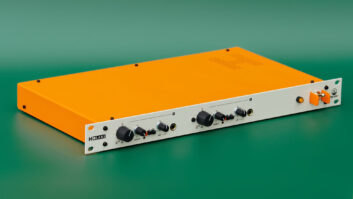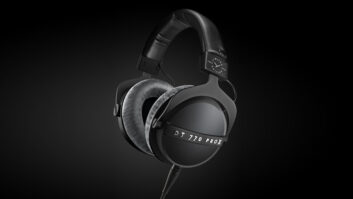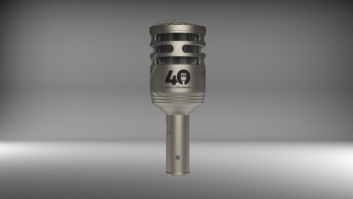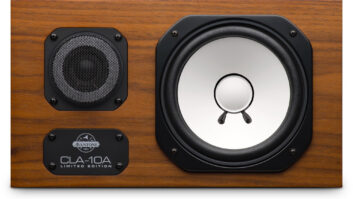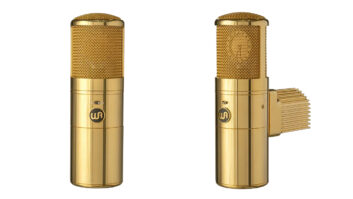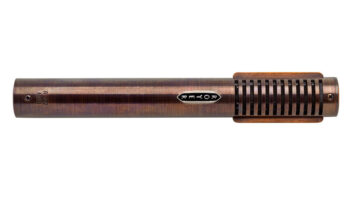The Brauner VM1 tube condenser microphone garnered a lot of praise
when it was introduced in 1994 because of its deft marriage of subtle
tube sweetness, remarkably low self-noise, open/revealing sound and
impeccable construction. The original VM1 didn’t sound like a vintage
tube mic; rather, it was a stunning example of the accuracy and nuance
that can be achieved using an innovative, contemporary tube-based transducer design.
At AES 1999, Dirk Brauner met Klaus Heyne (of Corbett, Ore.-based
German Masterworks). Heyne (who has modified and tuned innumerable
vintage mics for top recording studios and Grammy Award-winning artists
for more than 20 years) and Brauner forged an agreement to build a new
high-performance “super mic.” After a period of design,
experimentation and extensive field trials, the VM1 KHE possessed a
modified VM1 capsule design, modified VM1 circuitry, a different head
grille, a different power supply, and a special cable between mic and
power supply.
Hand-built in Brauner, Germany, and hand-tuned at German Masterworks
in the U.S., the result is a phenomenal microphone that retains its
precision pedigree and oozes with primal appeal. Find a sturdy door
jamb to stand under, folks—the new VM1 KHE is going to rock your
world!
FLIGHT TO QUALITY
The VM1 KHE ships in a lockable aluminum case. Also included are a
shock-mount, windscreen, and external power supply and connecting
cable. (The windscreen may be discontinued in an effort to keep the
price stable in the face of unfavorable exchange rates.) Every piece of
the system showcases superb craftsmanship, and a five-year
parts-and-labor warranty is included. The system lists at a whopping
$8,700 (user price is $8,199.99), making the VM1 KHE the world’s most
expensive microphone.
The side-address mic body is roughly two inches in diameter and 8.7
inches long. It’s quite heavy, weighing two ounces shy of two pounds.
In fact, the mic —fitted with its weighty suspension and
windscreen—proved to be too heavy for my workhorse AKG mic stands
in some applications. For example, placing the mic at the end of a long
boom arm (with the arm aligned parallel to the floor) caused the boom
arm to slip. Vertical placement never caused any slippage, but this mic
needs an extra heavy-duty mic stand for the most flexibility in
positioning. The good news is that its heavy body won’t resonate,
adding unwanted coloration to the sound source you’re recording.
The VM1 KHE is beautiful. The brass body is nickel-plated, and the
head grille for the dual-diaphragm capsule is domed at the top to
prevent internal standing waves from ruining the party. Its 27mm (about
11/2-inch) diaphragm is 6 microns thick. A single EF 86 tube sweetens
the deal.
The mic connects to the supplied PS1 KHE external power supply via a
special, RFI-rejecting, 7.5-meter cable fitted with Tuchel connectors.
All polar-pattern adjustments are made from the power supply, and a
switch is provided to select between two different directional modes.
One mode disconnects the rear-capsule side to provide a fixed-cardioid pattern with 4dB
The second directional mode allows for infinitely variable
adjustment of the polar
pattern—using a knurled rotary knob—from omnidirectional through
wide-cardioid, cardioid, supercardioid, hypercardioid and figure-8 patterns, serving up
intermediate patterns along the way. A front panel LED glows red in
cardioid-only mode, and glows green when in multipattern mode. Lower
your monitor feed before switching modes because moving the switch will
produce an audible pop.
No mic roll-off or
pad is provided for the VM1 KHE—in keeping with Heyne’s goal to
create a mic with “the most direct path and the least amount of
componentry between capsule and output.” You won’t need to pad
the VM1 KHE in most situations, anyway—the mic handles 138dB SPLs
for a conservative 0.3% THD. (Most mics’ max SPL specs are rated at
0.5% or 1.0% THD.)
In addition to the AC power switch, an 8-pin Tuchel mic connector
and an XLR audio jack
out on the rear panel of the power supply, you’ll find a three-way
ground-lift switch, which does not compromise the safety-earth
connection. One switch position lifts the signal ground, another
switches the XLR’s pin 1 to earth (“hard” ground), and the
third position couples the signal ground via a capacitor
(“soft” ground).
The VM1 must be secured to the supplied suspension mount in order to
place it on a mic stand. This shockmount is essentially a cylindrical
tube that floats on an elastomer suspension inside a concentric ring.
The VM1 KHE is secured by turning two integral rings that close around
the mic. This arrangement takes some getting used to, and mic
setup/take-down requires a little more time, but it dependably
safeguards this delicate instrument. A lever angles the suspension
mount through approximately 180° of rotation.
The VM1 KHE’s custom windscreen attaches to the suspension mount
with two screws. This, too, is more time-consuming than most
“slip-on” designs. The windscreen has nylon fabric
stretched over an acoustically transparent, stainless-steel mesh
grille. It encircles the mic 360° on a horizontal plane without
touching it. I found the windscreen to be fairly effective at
eliminating plosives while maintaining transparency.
Looking over the supplied specs, the VM1 KHE exhibits only 9dBA
self-noise in cardioid-only mode, which is quieter than any other
commercially available tube mic. Multipattern modes produce 11 dBA of
self-noise and a robust 28mV/PA output (sensitivity), regardless of the
pattern chosen. The mic’s frequency response is stated as 40 to 22k Hz,
-3 dB.
IN SESSION
I compared the VM1 KHE to my Lawson L47MP tube condenser, an admittedly
unfair comparison considering that the Lawson costs less than a quarter
of the VM1 KHE’s asking price. But the A/B comparison to the well-known
L47MP will give you some idea as to how the Brauner mic sounds.
Imagine adding some top-octave boost to the L47MP, tightening up the
bass, clarifying the low mids and offering faster transients, and
you’ve got a rough idea as to how the VM1 KHE sounds. It is much more
articulate, open and revealing of subtle nuance, resulting in a more
3-D sound. The bottom end is just as big as that produced by the L47MP,
but much more focused. The VM1 is also much quieter and considerably
more sensitive than the L47MP. Keep in mind that while the L47MP is an
incredible mic for the money and one of my favorite mics, it just can’t
compete against a sky’s-the-limit, no-compromise design.
The VM1 KHE’s cardioid-only mode exhibits a highly uniform off-axis
response and consistent sensitivity out to 45° to either side of
0° (on-axis), allowing a vocalist to move around a lot without
adversely affecting the captured timbre and levels. Off-axis response
is also uniform in omni mode, with the exception that close-miked
sources arriving at 90°/270° suffer from a mild acoustic
shadow effect caused by the head grille’s structural reinforcement. The
figure-8 mode offers excellent off-axis response and null-point
rejection.
The VM1 KHE sounds phenomenal in cardioid-only mode. Male and female
lead vocals were detailed, round, open and warm, with a big and
unobtrusive bottom. The mic’s HF reproduction is especially noteworthy,
and not even the slightest bit spitty or smeared. The VM1 KHE is
articulate in the sweetest way imaginable.
Recording flute with the VM1 KHE in cardioid-only mode—in
combination with my Universal Audio 2-610 mic pre and LA-2A
compressor—I was floored by the track’s striking realism, depth
and nuance. This signal chain offered the perfect balance of warmth,
clarity and detail.
Recording bowed and pizzicato violin in cardioid-only mode, this
time using my Millennia HV-3 mic pre and the LA-2A, the sound was warm,
smooth, pretty, full-bodied but clear, and brimming with detail and
nuance. The depth was astounding, and the highs sweet and richly
textured. The VM1 KHE is hands-down the best mic I’ve heard on
violin.
The VM1 KHE proved its superior transient response on a hand drum
track, recorded in cardioid-only mode with the HV-3. The highs were
prominent without sounding the slightest bit glassy or smeared. And the
low end was faithfully reproduced.
I’m not a huge fan of the sound of figure-8 mics on lead vocals, but
a bi-directional pattern is often needed for isolation purposes when
recording a singing instrumentalist. The VM1 KHE sounded more open and
articulate than any other mic I’ve heard in this application.
CONCLUSIONS
In an industry where every new product is routinely proclaimed as the
best thing since sliced bread, the VM1 KHE lives up to the hype. The
mic’s performance completely fulfills what one would hope and expect it
to achieve, given its lofty price. The VM1 KHE offers a
bigger-than-life sound more often associated with vintage mics, but
somehow manages to retain the superior noise performance, coherence and
high-frequency extension that only rigorous modern engineering methods
and componentry can produce.
Few people can afford to spend over $8,000 on one mic. But if I ever
get a windfall, I will not hesitate to buy the VM1 KHE. Simply put, the
VM1 KHE is the overall best-sounding and most versatile mic I’ve had
the pleasure to work with, and it’s worth every dime.
Dist. by TransAmerica Audio Group, www.transaudiogroup.com
